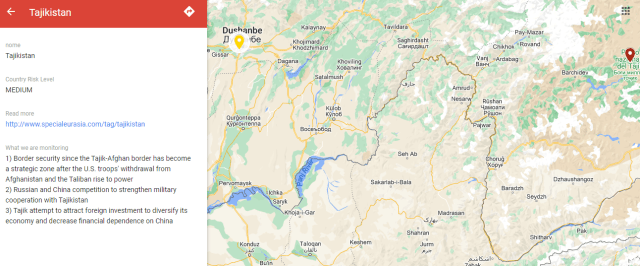
Author: Giuliano Bifolchi
The establishment of Tehrik-e Taliban Tajikistan (TTT) alarmed Dushanbe Government and highlighted how the security situation in Central Asia linked with Afghanistan has deteriorated since the Taliban took power in Kabul in August 2021.
According to several local sources and different Telegram channels, Tehrik-e Taliban Tajikistan (the Movement of the Taliban of Tajikistan – TTT) was formed in northern Afghanistan to unite people from Tajikistan under the Taliban brand and overthrow the Government in Dushanbe. The leader is Mehdi Arsalan, aka Mohammad Sharipov, a native of the Nurabad region of Tajikistan who had previously moved to Afghanistan, where he fought in the ranks of the Afghan Taliban.
Previously, Mehdi Arsalan headed the Jamaat Ansarulla group, recognised as a terrorist group in Tajikistan. According to local sources, this organisation was created over a decade ago to fight the Government of Emomali Rahmon by anti-government Islamist forces field commanders during the 1992-1997 Tajik civil war. Since the Taliban came to power in August last year, members of Jamaat Ansarullah have been entrusted with the administration of the Tajik-Afghan border in five districts: Kuf-Ab, Khwakhan, Maimai, Nusay and Shikai.
Geopolitical scenario
Since the U.S. troops’ withdrawal from Afghanistan and the Taliban’s rise to power in Kabul, the geopolitical risk of Central Asia has risen due to the fear that the Afghan territory could become a springboard for various terrorist groups interested in operating in the region. Indeed, under the Taliban rule, Kabul has not proven its ability to contrast jihadist propaganda and terrorist activities carried out by several terrorist groups, especially the Islamic State Khurasan Province (ISKP) (Uncertainty and instability in contemporary Afghanistan).
In this regard, Tajikistan has consistently expressed concerns about the security situation, the Tajik-Afghan borders, and the Taliban’s rule in Afghanistan, which Dushanbe has interpreted as a threat to its national security and stability.
Dushanbe has increased military and security cooperation with Moscow, which had a military base in the country, and Beijing, which supported the Tajik Government in the project to establish a military base in the Gorno-Badakhshan Autonomous Region (GBAO), to address the security and terrorist problems in the area (Tajikistan: the Kremlin’s frontier against the Taliban; Chinese military base in Tajikistan: regional implications).
Recently the Tajik central authority managed local demonstrations in the Gorno-Badakhshan Autonomous Region (GBAO), which resulted in numerous casualties after the Ministry of Internal Affairs launched an ‘anti-terrorist operation’ to eliminate any potential threats of destabilisation (Political tensions and security threats in Tajikistan).
Terrorism has become a severe threat in Tajikistan. Indeed, the Prosecutor General of the Republic of Tajikistan stated that the number of terrorists and extremists has increased over the past six months. Tajik security forces registered in the first half of the year 720 crimes related to extremism and terrorism. According to Rahmon, this is 106 illegal acts more than in the first six months of 2021 (The number of terrorists and extremists has increased in Tajikistan).
Among the threats to Tajik security, there is also the Islamic State Khurasan (ISKP) since the group started a jihadist propaganda campaign in the Tajik language to influence people in Tajikistan, especially the young generations dissatisfied with the Government, and to recruit foreign fighters to conduct local violent attacks (Islamic State Khurasan Province threatens Uzbekistan, Central Asia, and neighbouring countries).
Risk assessment
The rise of terrorist threats in Afghanistan and Tajikistan concerns regional actors involved in Central Asia, especially the Russian Federation and China. A stable and safe Central Asia is fundamental for Beijing’s Belt and Road Initiative and Moscow’s Eurasia Economic Union.
The creation of Tehrik-e Taliban Tajikistan highlighted that it is impossible to rely on the Taliban to guarantee security and stabilisation in Afghanistan and contrast terrorist groups such as the Islamic State.
Afghanistan might become a terrorist’ logistic hub’ or ‘paradise’ for different groups and foreign fighters. They might use the Afghan territory to organise violent attacks in neighbouring Central Asian countries and promote their jihadist propaganda.
Tehrik-e Taliban Tajikistan, like other terrorist groups, might exploit local socio-economic problems fuelled by the latest demonstrations and protests such as in Kazakhstan, Gorno-Badakhshan Autonomous Region (Tajikistan), and the Republic of Karakalpakstan (Uzbekistan) (Central Asian republics between socio-economic projects, widespread protests, terrorist threats and the Afghan dilemma). Furthermore, Tehrik-e Taliban Tajikistan might support the Taliban’s fight against the National Resistance Front of Afghanistan led by Ahmad Massoud and discourage Tajik authorities from supporting him.



